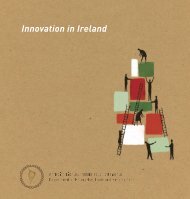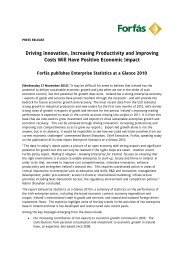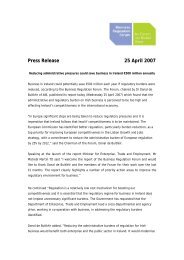Services Innovation in Ireland - Options for ... - Europe INNOVA
Services Innovation in Ireland - Options for ... - Europe INNOVA
Services Innovation in Ireland - Options for ... - Europe INNOVA
Create successful ePaper yourself
Turn your PDF publications into a flip-book with our unique Google optimized e-Paper software.
attention. In the context of the case studies, sectoral networks (both national and <strong>in</strong>ternational)<br />
were identified as important mechanisms to share knowledge, particularly amongst non-competitors.<br />
Aga<strong>in</strong>, the enabl<strong>in</strong>g approach was felt to be most appropriate.<br />
R&D was also highlighted <strong>in</strong> the case studies. Here, a number of companies <strong>in</strong> sectors such as IT<br />
and traded e-learn<strong>in</strong>g services were already active <strong>in</strong> systematic R&D. For most of the case study<br />
companies, however, R&D was viewed as a largely alien concept. For some companies, this was an<br />
issue of better educat<strong>in</strong>g service companies on the availability of such <strong>for</strong>ms of support and its<br />
applicability and availability <strong>for</strong> service <strong>in</strong>novation projects. For others, however, it was viewed as<br />
suggest<strong>in</strong>g the need <strong>for</strong> more specific service research projects, with a sectoral focus.<br />
Other examples of support were identified by s<strong>in</strong>gle companies and are not discussed <strong>in</strong> detail<br />
here due to lack of correspond<strong>in</strong>g evidence. For example suggestions focus<strong>in</strong>g on the role and<br />
contribution of the education sector to services <strong>in</strong>novation, <strong>in</strong>clud<strong>in</strong>g the role of schools <strong>in</strong> rais<strong>in</strong>g a<br />
culture of <strong>in</strong>novation from a young age were made. While this is not a specific services <strong>in</strong>novation<br />
issue, the notion that a more effective culture of <strong>in</strong>novation can benefit from a focus on issues<br />
such as flexibility and <strong>in</strong>novativeness at an early stages of education. At the same time co-operative<br />
placements between universities and enterprises were also noted as a means of facilitat<strong>in</strong>g more<br />
relevant curriculum developments to the needs of the service sector.<br />
These f<strong>in</strong>d<strong>in</strong>gs do not provide a strongly or coherently argued case. This could be taken to imply<br />
that such companies do not have a strong need <strong>for</strong> services <strong>in</strong>novation supports, as may <strong>in</strong>deed be<br />
the case <strong>for</strong> the larger companies studied, or it may correspond to the services <strong>in</strong>novation literature<br />
which stresses that the dom<strong>in</strong>ant language of <strong>in</strong>novation revolves around technological concepts<br />
such as R&D and may there<strong>for</strong>e be fundamentally <strong>in</strong>compatible with discussion around the needs of<br />
services <strong>in</strong>novation.<br />
4.6 Summary<br />
The ma<strong>in</strong> evidence base <strong>for</strong> service <strong>in</strong>novation activity <strong>in</strong> <strong>Ireland</strong> is currently provided by the CIS 75 .<br />
Data from the most recent published CIS3 (2003) suggests that higher levels of <strong>in</strong>novation are found<br />
<strong>in</strong> manufactur<strong>in</strong>g, compared to the services sector. The case studies, however, do not pa<strong>in</strong>t a picture<br />
of a laggard sector; <strong>in</strong>deed they suggest that that service companies <strong>in</strong> <strong>Ireland</strong> are evolv<strong>in</strong>g and<br />
<strong>in</strong>novat<strong>in</strong>g on a constant basis, <strong>in</strong> each of the different sectors exam<strong>in</strong>ed. Such <strong>in</strong>novation, however,<br />
with the exception of IT based service sectors, does not necessarily follow traditional <strong>in</strong>novation<br />
metrics such as R&D. Instead, the framework that was outl<strong>in</strong>ed <strong>in</strong> Chapter 2 helps to reveal a rich<br />
pattern of <strong>in</strong>novation activity <strong>in</strong> relation to bus<strong>in</strong>ess models, customer <strong>in</strong>terfaces and new services.<br />
In relation to the <strong>in</strong>novation models, while examples were found of each model, the case studies<br />
suggest that relatively few companies utilise a fast track approach, which is viewed as overly risky,<br />
<strong>in</strong>stead preferr<strong>in</strong>g a comb<strong>in</strong>ed approach built on systematic service development, complemented by<br />
more <strong>in</strong>cremental changes once implemented.<br />
The case studies also revealed different organisational models of <strong>in</strong>novation. In this respect the<br />
ma<strong>in</strong> approach <strong>in</strong> evidence was one based on <strong>in</strong>novation champions. This was not necessarily a<br />
<strong>for</strong>malised approach based on job titles and so on. In most cases champions were self selected from<br />
senior management teams. More <strong>for</strong>mal approaches were, however, <strong>in</strong> evidence particularly <strong>in</strong> larger<br />
companies and software driven sectors, where organised <strong>in</strong>novation teams were <strong>in</strong> evidence – often<br />
coalesc<strong>in</strong>g around a particular project requirement. These relatively ‘elite’ approaches to <strong>in</strong>novation<br />
did, however, contrast with more ‘democratic’ approaches based around empowerment of the entire<br />
work<strong>for</strong>ce that was evident <strong>in</strong> a small number of case studies.<br />
75 Other surveys such as the annual Forfás BERD survey provide a useful complement, but does not provide a detailed breakdown of the<br />
service sector.<br />
53

















